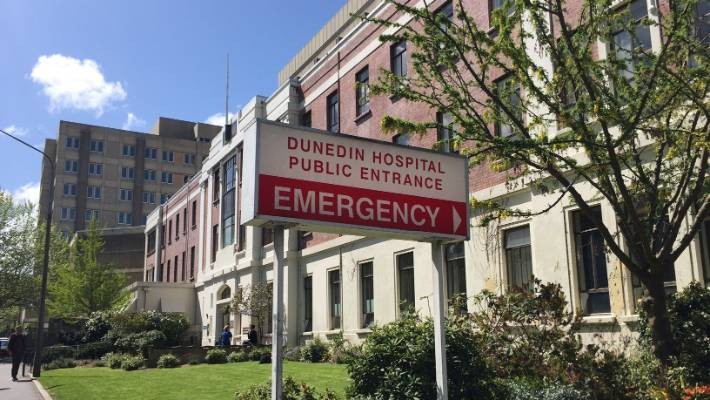The word “blow-out” is such a politically loaded term. It carries a strong whiff of extravagance and incompetence. In fact, and with public health budgets in particular, going “over budget” is a sign that reality has finally caught up with what – from the outset – was always a budget too inadequate to sustain the delivery of even core health services.
Regardless, Finance Minister Nicola Willis was still insisting this morning that Dunedin’s promised new hospital project has gone “ off track” and that we all “need to be sensible.” So let’s be sensible. Let’s recognise that the increase in costs for Dunedin’s new hospital has been the absolutely normal, bog-standard cost escalation you would expect to see (a) seven years down the track from the original costings, and (b) after the government has added extra items onto the project shopping list, in order to exaggerate the size of its cost burden.
Look at the figures. The original cost in 2017 was $1.2 to 1.4 billion. In the seven years since then, inflation has risen by 17.85%. That alone would add roughy $250 million to the 2017 starting figure and take the total to $1.65 million. Then, as mentioned, the coalition government has added $400 million for other items not included within the original scope of the project – e.g. $45 million for car parks, a pathology lab, and $325 million for the decommissioning and refurbishing of the existing hospital site.
In addition…over the past few years, successive governments have recognised that inflation (and the soaring construction costs post Covid) were pushing up the cost of the original project. That’s why the Labour government approved capital funding to $1.59 billion, and this year’s Budget topped that up by a further $290 million, which brings us to the government’s current ‘line in the sand’ figure of $1.88 billion for the entire build.
No blowout. Just inevitable cost escalation over time. Even so, there are valid concerns about the $1.88 billion figure. Page 9 of the government-commissioned Rust Review kicks off its discussion of “ Costs” with this observation:
The approved budget for the NDH [New Dunedin Hospital]Facilities is $1,880m. In addition, there is an approved Data and Digital Budget of $225 million as we understand it.
Immediate question being… is that $225 million for the Data and Digital Budget now tucked in under the government’s $1.88 billion ceiling, or is it still to be regarded as “additional” – as Robert Rust rightly assumed it to be? In which case, the realistic starting point is $2.1 billion (a) before there is any trace of an avoidable “blow-out” and (b) before we take on board the “hyper-escalation” in construction costs that Rust acknowledged (p. 21) has occurred since the pandemic.
“Hyper-escalation” is the right word. As the government concedes, the construction costs have risen from $10,000 per square metre at the project outset to $30,000 per square metre today. Rust also says: “In addition, professional fees remain a relatively high-risk budget item given the propensity of variations associated with design development and scope changes on most major, complex projects…” Hmm, that’s interesting. It looks as if Dunedin is now at risk of being denied a hospital facility of the quality promised, partly because the fees charged by the project’s design professionals and consultants have gone through the roof since 2017.
It is not as if Dundein hadn’t already sensed that the new facility was under pressure from these inexorably rising costs. Rust cites the “on-going areas of concern” expressed by the clinicians working within the project’s transformation group. Rust’s listed concerns include:
- Pathology Services
- P.E.T. Scanning Services
- Reduction in the number of Inpatient Beds
- Reduction of two Operating Theatres
- The removal of the Interprofessional Learning Centre and
- The delay in approval of resources for Transition Operational Planning for the Outpatient Building.
Except for that last item, Rust said, “These omissions were generally made in response to the largely COVID inspired hyper-escalation of construction costs, and the need to reduce the scope of the facility to fit within a budget that only went part way to offsetting the cost increases.”
In Rust’s own words then, the budget for the hospital has always been inadequate for purpose, and unavoidable costs were already threatening to undermine the quality of the new hospital. Willis is now chiding the Otago region to be “ sensible” and to accept cuts into the very sinews and bone of the promised project, and for highly dubious reasons to boot. To repeat: this project has never gone “off track.” Nowhere in the Rust Review is the figure of $3 billion even mentioned.
Yet…just for argument’s sake, let’s assume this worst case scenario is a reality. That $3 billion figure would still amount to less than 1% of the nation’s current GDP. i.e. it seems entirely reasonable for the lower South Island to want its (relatively small) fair share. Besides, at the high end figure of $3 billion, the final cost of the Dunedin hospital would still be less than what the coalition government’s own $14 billion tax cuts package will cost the country every year [i.e. $3.5 billion] for the next four years. Infamously, $3 billion has been set aside to restore a tax break for landlords.
In recent years, another $3 billion has been spent on buying, kitting out, housing and providing data support for the Air Force’s four Poseidon P-8 surveillance planes. Question: should we have spent $3 billion on four aircraft to detect phantom Chinese submarines in far-off waters, or should we spend much the same amount on a modern new hospital to meet existing and future health needs, right here at home?
In other words, the availability of funding always comes down to a political choice. National is choosing to break its election promises to Dunedin. The only people who have gone “off track” here are Christopher Luxon and Nicola Willis.
The Catchment Area
Keep in mind that this new hospital has to serve an area that comprises one quarter of the landmass of the entire country. As well as serving Dunedin city, the hospital would also be providing modern health services for the entirety of Otago and Southland. Politically speaking, the coalition government may think it can afford to infuriate voters in Dunedin city – a Labour/Green stronghold – but the hospital’s catchment area also includes a rural hinterland that stretches right across much of southern New Zealand. Some of those rural centre-right voters will be just as infuriated by this exercise in selective frugality. In effect, National is treating them as being expendable.
In that respect, Infrastructure Minister Chris Bishop’s patronising tone has only added insult to injury. “The government,” Bishop told RNZ, “doesn’t have an unlimited money tree for health infrastructure.” The gibe seemed to be an attempt to shift the blame for National’s broken promise onto the people of Dunedin, as if their expectations had always been unrealistic.
That’s galling, given that – as mentioned – the government’s money tree seems to be in full flower for other priorities. Other areas of potential savings that could usefully be turned in Dunedin’s direction include: the circa $216 million tax break made available to Philip Morris, after the coalition government spurned the advice of health experts, and halved the excise tax on the company’s heated tobacco products.
In contrast to its U-turn in Dunedin, the coalition government seems to be intent on keeping its election promise to Hamilton voters, and will therefore be spending at least $280 million to help establish a new medical school at Waikato University. It is doing so even though a recent PWC report found that this would not be an efficient use of public money, and that better outcomes would be achieved more quickly by putting the money into boosting capacity at the two existing medical schools in Dunedin and Auckland:
The PWC report found more cost effective training could be delivered by the two existing medical schools and that both universities could also increase intake numbers more quickly with increased funding.
A new business case for the Waikato University project is due to be presented in 2025. This is disturbing, given that Dunedin’s new hospital is/was supposed to be central to the collaboration envisaged between Dunedin hospital, the Otago Medical School and Otago Polytechnic that was meant to train and boost the numbers and the skill levels of medical staff, including nurses. The legacy costs of re-inventing the wheel in Hamilton, while trying to funnel the training process through inferior hospital facilities in Dunedin are likely to be felt right across New Zealand for years to come.
Finally on the cost front, it is not as if the funds spent on Dunedin’s new hospital would be at the expense of other regional hospitals around New Zealand. If this was intended to be a political gambit of ‘divide and rule’, it has not succeeded.. Those other regions know that any money not being spent in Dunedin will not be spent on public health services in their neighbourhoods, either.
Bad Optics, Bad Options
Of late, the coalition government has been touting two previously rejected options for Dunedin. These are: (a) to reduce the new inpatient building drastically in scope, with fewer floors, fewer inpatient beds and delays in bringing parts of the facility onstream or (b) parking the new building for the foreseeable, and making do with “re-developing” the old, rundown leak-ridden hospital buildings, even while they remain in use.
The common theme to all of this is that providing quality public services in health and education simply does not seem to be a priority for this government. In a widely reported speech last week, Treasury’s Chief Economic Advisor Dominick Stephens signalled that we are facing a period of austerity measures of “unprecedented” severity from now until 2028, with this era of perpetual stringency being applied to health spending in particular:
Managing healthcare spending is central to the long-term fiscal challenge because it is a large and growing part of total government spending. Treasury modelling in 2021….showed that reducing the growth of health expenditure would contribute to a more sustainable trajectory for debt. Some savings can be made from a greater preventative focus and reducing inefficiencies but making substantive savings is likely to require some tough choices around entitlements….
Those choices will of course, be “tough” only for the sick people on the receiving end of the austerity cuts, and not for the Cabinet Ministers with private health insurance who will be making the calls. Nominally, health expenditure may increase each year, but this year it was at a rate that was reportedly only treading water, given inflation, chronic staff shortages, existing levels of unmet need and the fact that we have a growing and ageing population with more complex health needs, and which is demanding access to drug treatments that are more and more expensive.
Stephens reference to a “more sustainable trajectory for debt” was needlessly alarmist. As Stephens concedes elsewhere in his own speech: “Although New Zealand’s public debt levels are higher than anticipated back in 2006, they are still low by international standards.”
Exactly. Plus, there is no sign that investors are freaking out at the alleged dire state of the New Zealand economy, and are nervously reluctant to buy government bonds. Quite the reverse. They’re kicking down the doors, as Bernard Hickey eloquently explained a few weeks ago:
The Government keeps arguing its cuts on spending in real-per capita terms in health, education, child welfare, housing and public transport are needed to both pay for ‘income tax relief due to a cost of living crisis’ and to deal with ‘the dire state of the Government books we inherited.’ It also argues there’s ‘no money left’ when saying it will have to use private finance, tolls, water levies and congestion charges to pay for new roads, pipes, hospitals and schools, rather than Government borrowing.
Meaning: none of that pain has been necessary. As Treasury advice had earlier argued, the government continues to have ample headroom to borrow the money. Treasury has rejected ( as not being in the country’s long term interests) the government decision to embrace a 20-40% of GDP cap on core Crown debt. The Luxon government is imposing this borrowing restriction on itself (and by extension on the rest of us) purely in order to justify its ideologically-driven raft of austerity measures. As Hickey added, the professional investors know this. They don’t buy the government’s spin about the need for stiff medicine to correct the nation’s alleged ills:
But the professionals who analyse the Government’s books and have to put their money and careers on the line week after week by buying NZ Government Bonds (NZGBs) think there is no crisis whatsoever. Just last week, local and international bond fund managers and central banks bid a record $22.76 billion for an initial offering of $3 billion worth of a new 12-year Government bond with a fixed interest rate of 4.25%. The demand was so strong Treasury decided to double the amount of bonds it sold to $6 billion.
Which means…if only the will existed in the Beehive, we could easily borrow more to meet our infrastructure needs and to invest in future prosperity. The departmental spending cuts, the arbitrary job losses, the cuts to social services lectures have been conscious choices made by a government hostile to the very notion of the state being responsible for the delivery of public services.
In fact, the Treasury advice says that the state could borrow an extra $80 billion – to fund the quality infrastructure that we need if we are ever going to raise our productivity levels. There could be more than enough to provide Dunedin with the modern hospital facility that it needs, and was promised.
Footnote One: As the economist Ganesh Nana told Q&A‘s Jack Tame in a fascinating interview on the weekend, to the extent that we have a debt servicing problem in New Zealand, it is with regard to private sector debt, not government debt. Much of the private sector debt is due to people borrowing money from banks (the funds come from offshore) to buy houses.
We do that to excess because we don’t have a capital gains tax to deter it. In line with its anti-tax, Small Government ideology that became hard-wired into economic thinking here 30 or 40 years ago, the current government is opposed to having a capital gains tax. Or any new tax, on principle. Cutting services is its preference, not a pressing need.
Footnote Two: Talking of tax, the third alternative to (a) going without or (b) borrowing is that we could (c) raise taxes, or deploy targeted taxes – a wealth tax, a health tax – to raise the revenue for essential infrastructure projects, like hospitals. Stephens is pretty sure that sort of thing is never going to happen. Here is how that sounds in Treasury speak:
This means that the Government will have to increase revenue or reduce the amount that it spends per person, in inflation adjusted terms, to meet this target. This implies that savings and reprioritisation will likely be a feature of future Budgets, as in Budget 2024.The Treasury’s latest forecasts assume that most of the return to surplus will be driven by declines in per capita government [spending]….
Unfortunately, as Ganesh Nana indicates, New Zealanders have been conditioned by successive neo-liberal governments of the centre-left and centre-right to think of tax as something being taken away from us – rather than thinking of taxation as enabling us to get the services we want, we expect, and (increasingly)we demand. If we can believe Dominick Stephens though, austerity measures of “unprecedented” severity are about to be forced on us.
In that respect, the Dunedin hospital fiasco – and the ferries cancellation debacle – are merely signs of things to come.



